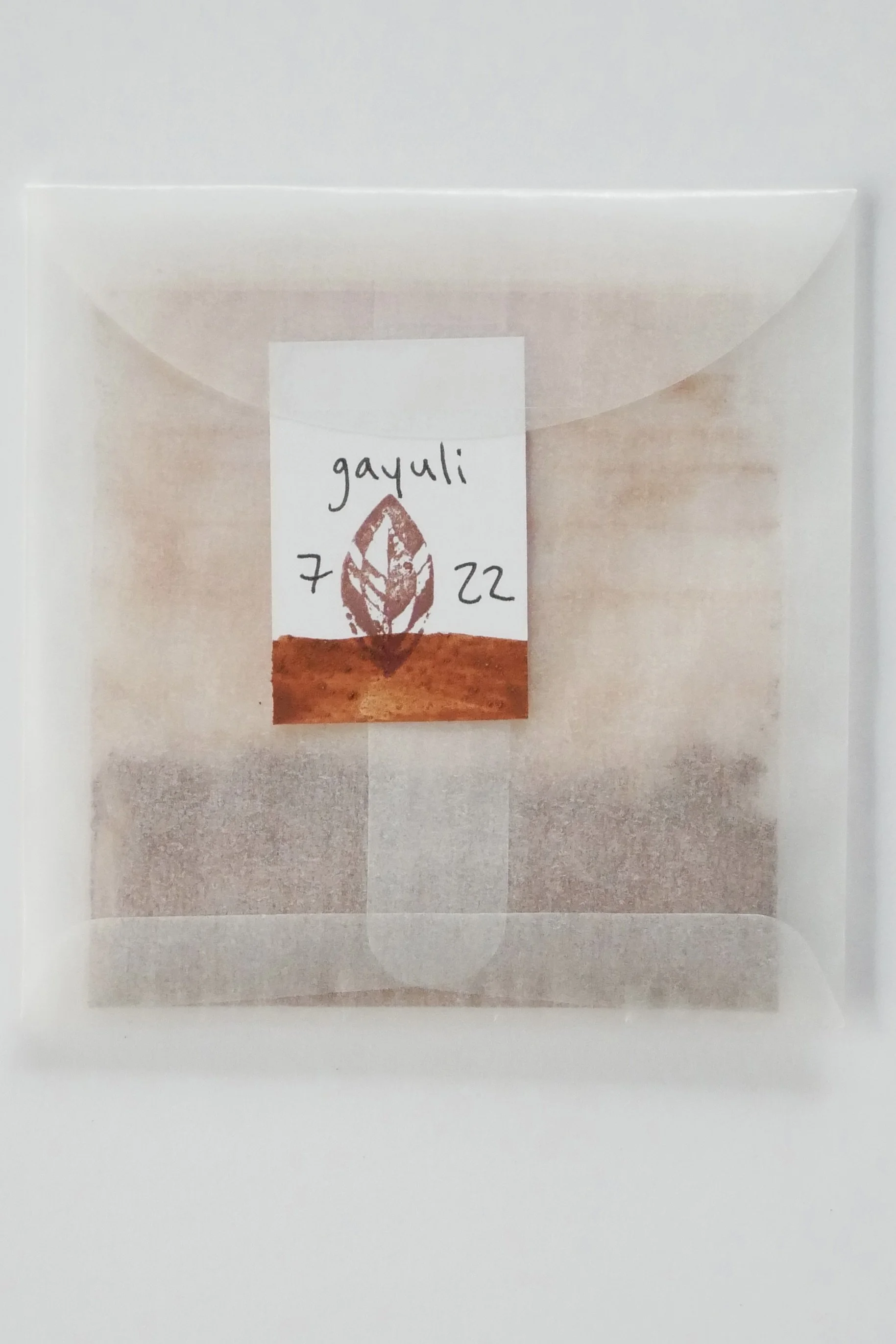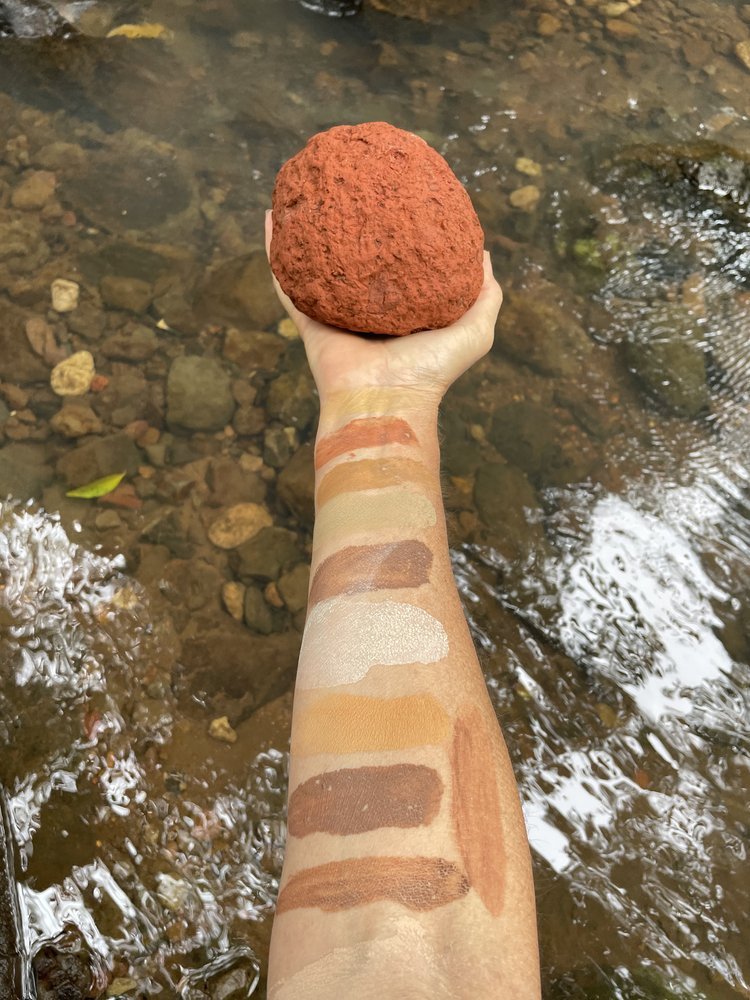gayuli : july ’22
The following is written by contributor, Melissa Ladkin:
‘The July pigment is called ‘Gayuli,’ which means ‘long way’ in the Bundjalung language.
The unceded land upon which this gudjing (red pigment) was collected with permission is that of the traditional owners and custodians, the Bundjalung peoples of the Bundjalung Nation. Australia consists of over 350 different Indigenous nations each with clan groups who have their own distinct dialects. There are some 600 plus languages across the country. The Bundjalung language belongs to the Pama-Nyungan family of Australian languages. At the time of first contact with Europeans there were up to 20 dialects of the language, which included the Wahlubal, Yugambeh, Birrihn, Barryugil, Bandjalang, Wudjebal, Wiyabal, Wuhyabal, Minyangbal, Gidhabal, Galibal, and Ngarrahngbal dialects. The arrival of Europeans in the 1840s had a dramatic impact on the lives of the Bundjalung people. From the 1860s, their lands were cleared and fenced, forcing them to live in camps on the edge of these newly formed towns. Sacred lands and hunting grounds were involuntarily turned into someone else’s property and families were torn apart to an extent that still impacts the new generations.
The Region (Far North Coast of NSW, Australia) covers an area of 10,293 square kilometers. The climate is generally subtropical, with warm humid summers and mild winters, a marked summer and autumn rainfall, relatively dry springs, and fine sunny days with cool nights in winter. From east to west, this region is characterized by coastal alluvial flood plains, rocky headlands, dune fields, lakes and estuaries, to midland hills and in the west and north, escarpment ranges. About 47% of the Far North Coast Region is covered with native vegetation in varying condition. The north-eastern area is characterised by the eroded caldera of Wollunbin (Mount Warning) and the associated highly and moderately fertile volcanic-derived soils.
There are three major river systems in the Far North Coast Region: The Upper Clarence, the Richmond and the Tweed. These rivers are stressed to some degree due to interference with flow patterns, water extraction, riparian degradation and reduced water quality. Since the 1850’s when the Far North Coast of NSW was ‘settled’, it has predominately become home to a range of primary industries, including agriculture, forestry, mining, and commercial and recreational fishing.
This gudjing (red pigment) was collected with respect and acknowledgement from a seam in a disused farming dam before the horrific floods of early 2022 in the area. I had not quite collected all required when the flood hit, and land slips presented all over the shire. The whole side of the hill fell into the old dam and covered it entirely with no sign of the seam anywhere. It seems the ancestors had spoken…
I pray that these ochres travel gently and land lightly with respect to ancestors & traditional owners of those lands.
When using this gudjing in your practice may I ask that you also pay respect & consider where it has come from: Bundjalung Country. May you consider the knowledge and wisdom it holds and speaks of. To all the ancestors who have come before, walking lightly on & with the lands of the Bundjalung peoples. To all we may learn from it and continue to practice from the stories it holds and the guidance it gives. Continue to ask deep questions within your own practice regarding the origins of your pigments & ochres, whose lands they come from, the names of them and their stories, spirits and sentients.
This gudjing has gone through ceremony and cleansing before leaving country.
I respect & understand that each different nation/clan/family group has its own history, traditional cultural practices, protocols and spiritual beliefs about ochres.I acknowledge the Traditional Owners of Country throughout Australia and recognize the continuing connection to lands, waters, skies and communities.
I pay deep respect & acknowledge my connection and ancestral ties to the lands that I live on and all Indigenous peoples globally.
…This always was, & always will be Aboriginal land….’
Melissa Ladkin
Awabakal / Wonnarua / Bundjalung
April 2022
contributor: Melissa Ladkin
Melissa is a contemporary Aboriginal artist living on Bundjalung country, Northern NSW. A proud descendant of the Awabakal / Wonnarua / Bundjalung peoples, Mel has been caring for country most of her life. From a young age she experienced a deep and intuitive connection to the land. She felt the earth speak to her and was moved by the richness and depth of the colours that form the many ochres she has come across over time. For the past 30 + years Melissa has worked in the bush, with native plants, trees & their habitats as a land conservationist and has always been fascinated with geology, rocks, minerals and soils. Working specifically with ochre, the careful and respectful collecting, to the processing is a significant and alchemical process, they are slowly blended and formed into pigment. This is a very personal journey, a time of deep connection and acknowledgement of all that have come before her. Melissa's collection of art works has evolved with much thought, care and respect. Her practise speaks of an ancient wisdom, and she hopes her work will inspire others to open to the spirit of the land and to the rich culture and knowledge that it holds. Find her on Instagram at @ochre.earth
Image courtesy of Melissa Ladkin.
Image from The Returning website.
22% donation recipient : The Returning
Melissa writes: “We (my people) never take without the rule or lore of giving back to the land in some way. We have upwards of 60,000 years of having a reciprocal relationship with the land. It warms my heart that the recipient of the Ground Bright 22% for this Gudjing (red pigment) donation will be going to someone very dear to me and the community of the Bundjalung Nation. Ella Bancroft is an Indigenous change-maker, artist, storyteller, mentor and founder of “The Returning.” She is an active advocate for the Decolonization movement. She is widely respected amongst her community and believes in local communities with local economies as a way to find hope for the health of our planet and people. The Returning is a Not-for-profit, grass roots collective that runs cultural camps for Indigenous peoples. It is also an event that takes place just outside of Byron Bay, Australia, providing a place for all women, of all walks of life to come together to relearn the way of their past, to connect to herbalism, activism, motherhood, health, movement and deep connection to the land.” More at www.thereturning.com.au and www.ellanoahbancroft.net




